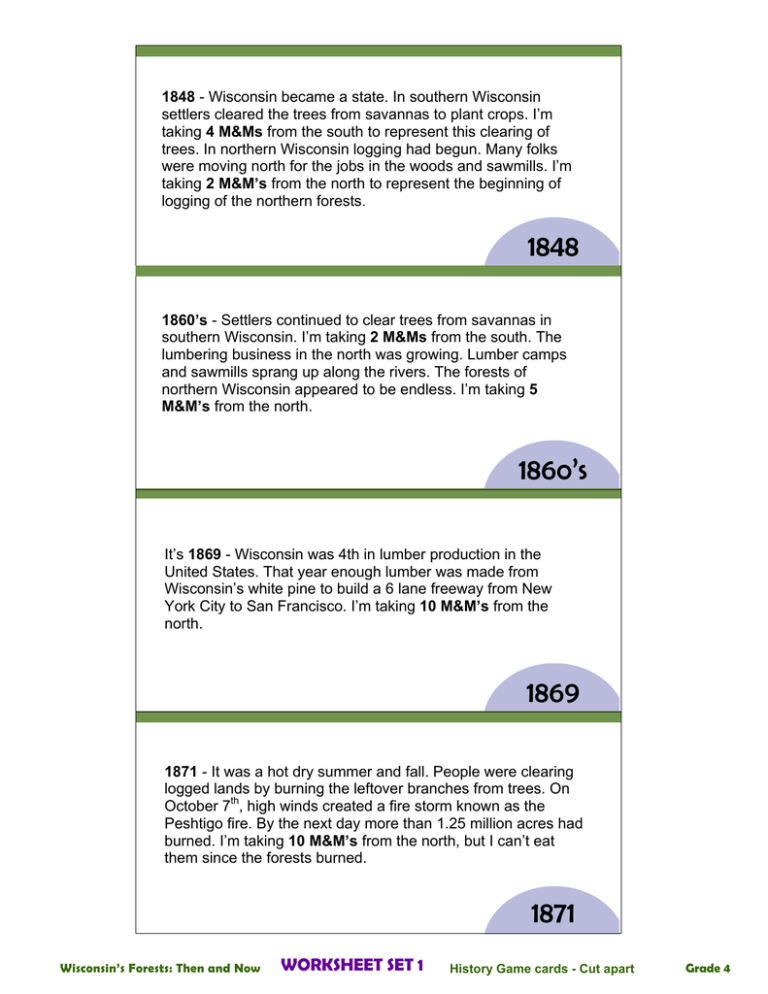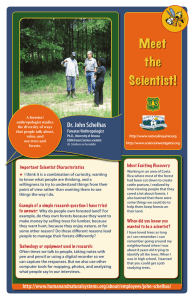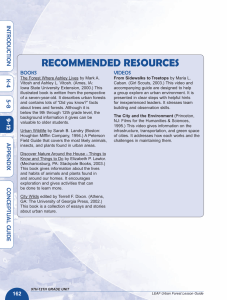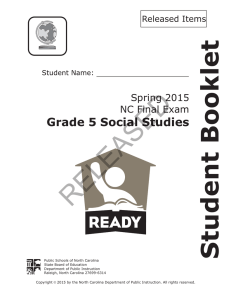settlers cleared the trees from savannas to plant crops. I’m 1848
advertisement

1848 - Wisconsin became a state. In southern Wisconsin settlers cleared the trees from savannas to plant crops. I’m taking 4 M&Ms from the south to represent this clearing of trees. In northern Wisconsin logging had begun. Many folks were moving north for the jobs in the woods and sawmills. I’m taking 2 M&M’s from the north to represent the beginning of logging of the northern forests. 1848 1860’s - Settlers continued to clear trees from savannas in southern Wisconsin. I’m taking 2 M&Ms from the south. The lumbering business in the north was growing. Lumber camps and sawmills sprang up along the rivers. The forests of northern Wisconsin appeared to be endless. I’m taking 5 M&M’s from the north. 186o’s It’s 1869 - Wisconsin was 4th in lumber production in the United States. That year enough lumber was made from Wisconsin’s white pine to build a 6 lane freeway from New York City to San Francisco. I’m taking 10 M&M’s from the north. 1869 1871 - It was a hot dry summer and fall. People were clearing logged lands by burning the leftover branches from trees. On October 7th, high winds created a fire storm known as the Peshtigo fire. By the next day more than 1.25 million acres had burned. I’m taking 10 M&M’s from the north, but I can’t eat them since the forests burned. 1871 Wisconsin’s Forests: Then and Now WORKSHEET SET 1 History Game cards - Cut apart Grade 4 1892 - Lumber output reached a new high. Lumberjacks cut four times as many trees this year as they did in 1869. That’s enough lumber to lay down a road one-inch thick from New York to San Francisco as wide as a football field is long. I’m taking 20 M&M’s from the north. 1892 1897 - Even more trees are harvested. Studies warned that logging in Wisconsin could only last 10 more years. Forests had been cut faster than they could grow back. By 1897 only one-seventh of Wisconsin’s forests remained. I’m taking 20 M&M’s from the north. 1897 1899-1904 - The forests of Wisconsin were logged at an even faster rate. Wisconsin was number one in lumber production in the nation. I’m taking 20 M&M’s from the north. 1899-1904 1905 - Most of the white pine was gone, but logging continued. The railroads transported hardwood logs to the mills. I’m taking 5 M&M’s from the north. 1905 Wisconsin’s Forests: Then and Now WORKSHEET SET 1 History Game cards - Cut apart Grade 4 1907 - Wisconsin set aside 3,000 acres of land as the first state forest. The land didn’t have many trees on it, so Wisconsin began planting trees. I’m putting back 2 M&M’s. 1907 1908 - People used fire to burn the branches and limbs left from logging. Many of those fires got out of control. More than 1,400 fires burned over 1.25 million acres. I’m taking 10 M&M’s from the north, but I can’t eat them since the trees all burned up. 1908 1911 - The first State tree nursery was built in Trout Lake, Wisconsin. With all of the forest lands that had been logged, burned, and eroded, there was a need to replant the forests. I’m adding 10 M&M’s to the north. 1911 1923 - Most of the large trees had been cut. Smaller trees were cut for pulp, which is used to make paper. The paper companies started planting trees to provide pulp for many years to come. I’m going to take 2 M&M’s for the trees harvested for pulp, but I am putting 10 M&M’s back for the trees replanted. 1923 Wisconsin’s Forests: Then and Now WORKSHEET SET 1 History Game cards - Cut apart Grade 4 1927 - Since logging started after statehood, people had cleared land for farming. Crops didn’t grow well in many areas of the north and by 1927 many farms had been abandoned. No one paid the taxes on the abandoned land, so the counties got the land back. I’m not sure if I get any M&M’s. 1927 1933 - The Great Depression hit the United States. Many people were out of work. A program called the Civilian Conservation Corps provided jobs for men out of work. The workers played a big role in renewing Wisconsin’s forests. I’m putting back 40 M&M’s. 1933 1950’s-1960’s - Our forests had finally grown back in the north. Trees were still being logged, but foresters managed the forests so that no more trees were removed each year than grew back. I’m going to add 5 M&M’s for the tree growth, but I’m going to take 5 M&M’s for the trees harvested. 1950’s-1960’s 1970’s-Today - People recognized that forests provided more than wood products. Forests provide recreation, homes for wildlife, and take care of our air and water. Sustainable forestry manages forests for all the benefits they provide, not just wood. How many M&M’s do I get? 1970’sPresent Wisconsin’s Forests: Then and Now WORKSHEET SET 1 History Game cards - Cut apart Grade 4 When it rains on a forest, tree leaves slow down the falling rain and tree roots help hold soil in place. When all the trees were logged, rains washed away the soil on hills. The rainwater washed ditches into the soil. This is called erosion. Erosion As trees were logged, the tree tops were left behind. These tree tops were called slash. People clearing the land for farming burned the slash. Slash fires often spread burning trees, farms, and whole towns. Fire The white pines of Wisconsin were used to build cities and farms. The need for Wisconsin’s lumber led to the logging of Wisconsin’s forests by the lumberjacks. With a crosscut saw and axe lumberjacks removed the forests. Logging As the trees in the forest were cut down, the land was sold to immigrants for farming. Removing all the stumps and rocks was hard work. Much of northern Wisconsin was not really good for farming. The weather was harsh and the soils poor. Forests Become Farms Wisconsin’s Forests: Then and Now WORKSHEET SET 2 Then or Now cards - Cut apart Grade 4 Lumberjacks lived in lumber camps out in the forests. These camps included bunk houses where they lived, a dining hall to eat in, barns for horses, a blacksmith shop, and more. Life was hard in the lumber camps. Men worked in the forest from daylight until dark all winter. Lumber Camps The first forests to be logged were near rivers so the trees could be floated to the sawmills. As the forests near rivers were gone, railroads were put in the forests to get the logs to the river or to the mill. Railroads made it possible to log trees with leaves and get them to the mill. Railroad Once logs were cut they were stacked near rivers. In the spring when the ice and snow melted, the rivers filled up with water. The lumberjacks rolled the logs into the rivers. They used pike poles to push on the logs to keep them moving. They floated the logs down river to the sawmill. River Drives Buildings at this time were built mainly from wood. It took a lot of lumber to build all the houses, factories, and stores. There was a lot of work for carpenters as new buildings were built. Cities Built from Wisconsin Lumber Wisconsin’s Forests: Then and Now WORKSHEET SET 2 Then or Now cards - Cut apart Grade 4 Sawmills provided jobs for people. Towns were built around sawmills, with stores to provide all the things people needed to live. Schools, churches, and hospitals were built. All of these provided jobs. Towns Spring Up Around Sawmills Tree seeds are planted in nurseries to grow seedlings. The seedlings are small trees that are used to replant forests. The State of Wisconsin owns 3 nurseries. Other companies run nurseries too. Many people work to grow and dig the seedlings so others can plant them. Nurseries Small trees are planted to help start a new forest. Small trees are planted by hand or with a machine pulled by a tractor. In people’s yards, bigger trees are planted. A shovel is used to dig a hole. Planting Trees Forests are constantly changing. New trees grow, some are harvested for lumber, and others die. Sustainable forestry makes sure more forests grow new each year than are harvested for lumber. Trees Grow Faster Than Logging Wisconsin’s Forests: Then and Now WORKSHEET SET 2 Then or Now cards - Cut apart Grade 4 Farm machinery has become larger. It is hard for farmers to work small fields with big machinery. Many of these small fields aren’t farmed any more. Tree seeds have started in these small fields and new forests have grown. Wisconsin Gains Forest Land The reasons people own forests are changing. Many people buy forests for recreation. They may hunt, camp, bird watch, or just relax in their own forests. People Buy Forests for Recreation Many forest fires burn each year, but we have a system for fighting the fires. The fires are spotted from fire towers or airplanes. Fire engines and bulldozers work to keep the fire from spreading. Airplanes are used to drop water on the fire. Fire Control The trees in my town are part of an urban forest. They provide some of the same things that rural forests provide. Tree shade cools my house, blocks the winter winds, and cleans the air I breath. Urban Forests Wisconsin’s Forests: Then and Now WORKSHEET SET 2 Then or Now cards - Cut apart Grade 4






